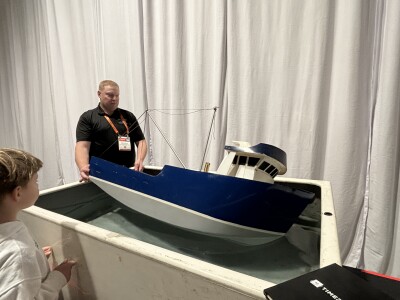Quality is king these days in Bristol Bay, Alaska. Well, so is quantity, especially after the bay tallied its biggest run in 125 years this season. But back to the quality thing. The Bristol Bay Regional Seafood Development Association has spearheaded a push for colder, less traumatized fish, working with fishermen, processors and buyers to get more and better fillets to consumers around the world. And it all starts with keeping fish cold from the moment they come out of the water.
“Chilling fish is about storing value, because you increase shelf life, and there’s a definite mathematical relationship between the value of the fish and how much shelf life it has once it’s processed. That all starts on the grounds with the chilling, and it goes right down the chain of custody into retail,” said Mike Ficcero, BBRSDA’s board president.
To that end, BBRSDA was at Pacific Marine Expo in Seattle this week, promoting new ice totes they hope will allow them to get more and better ice to Bristol Bay’s fleet, especially in remote districts on the east side of the bay like Egegik.
“We knew we needed to get more ice around the bay. It’s so important, a lot of boats take it, and chilling is critical the quality of the fish. Ice obviously melts on the tenders, and these insulated bags will allow us to have more efficient ice delivery,” said Andy Wink, the new executive director at BBRSDA.

The first bags will be rolled out in 2019.
Cameo Padilla, BBRSDA’s program manager, worked with Seattle Tarp and others to make the first bags, which will be rolled out in 2019.
“There was a program back in 2014 that tested these insulated bags, so this takes all that information and upgrades it so we can get the best ice retention,” Padilla said.
It’s also a matter of space. Tenders were refusing ice in totes because they didn’t have room on deck to bring them back across the bay with loads of fish. These pliable totes fold up easily and can be stored out of the way.
Each bag also features a lid, a dump strap on the bottom, and webbing with handles to manipulate them on deck. The two designs on the floor at Expo were made to hold 500 and 1,500 pounds of ice, respectively, but Padilla and Ficcero think the ideal size might be somewhere in between.
Ficcero, who fishes in the Egegik district, said he’s seen a lot of half-melted blocks of ice come off tenders over the years, the type of transaction that’s more for checking the box than actually chilling the fish.
“Ice has a thing where it kind of expends its energy after sitting for a while and is no longer as effective. These bags are designed to keep the ice fresh and allow for good distribution that will actually chill fish,” Ficcero added.
Wink points out that it’s all in line with the mission, which is to get more fish, of course, but also to get more for your fish.
“Chilled fish get bonuses. Chilled fish are worth more, and this is just going to put more chilled fish onto the tenders and into the processors. And its residual gains. You feed someone a good piece of fish, and they’re going to buy more,” Wink said.
And after fishermen got $1.26 on average per pound in the bay last season, it’s likely BBRSDA has the industry’s ear.







